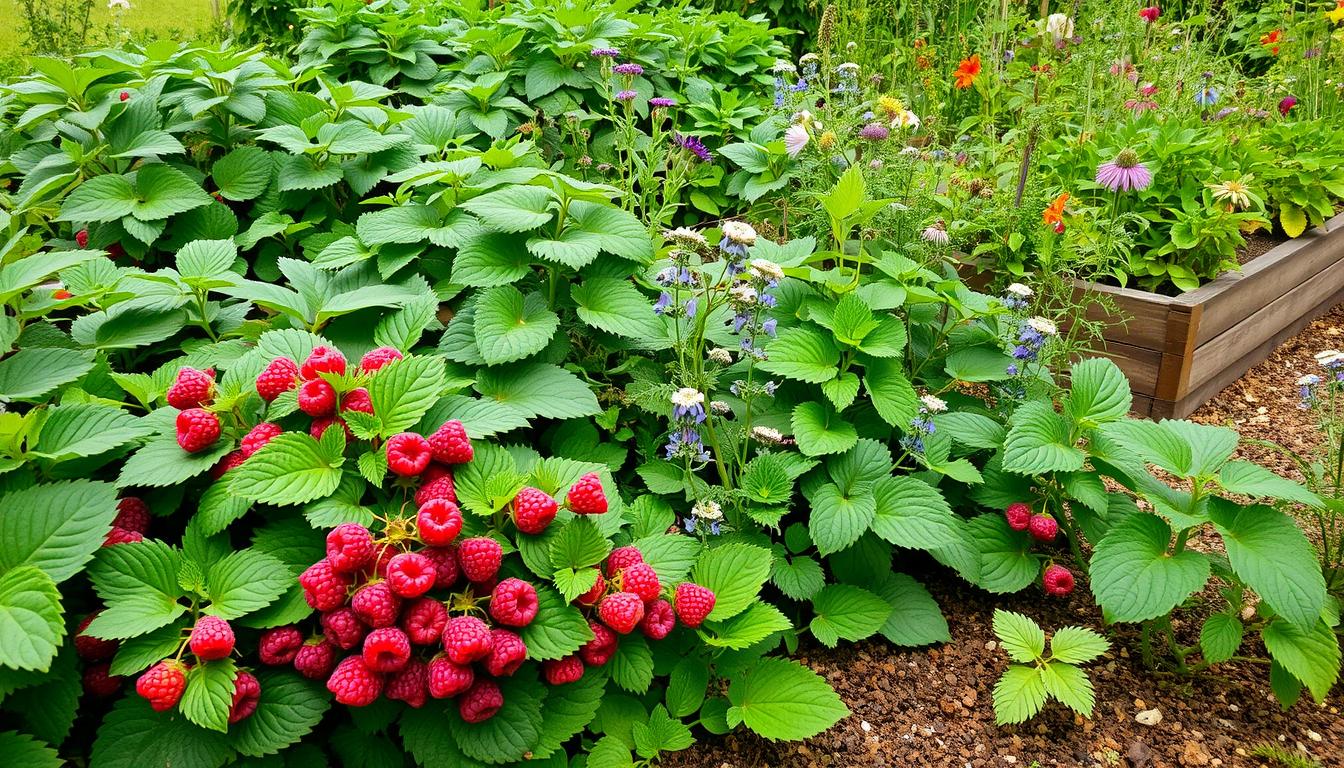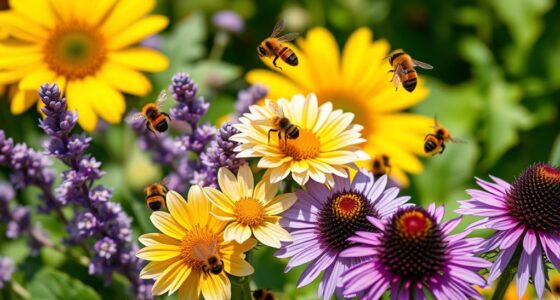Imagine stepping into your garden, where the sun warms your skin and the sweet, rich scent of ripe raspberries fills the air. It’s not just the promise of a fruitful harvest that excites you; it’s the knowledge that these vibrant plants thrive alongside companions that nurture and protect them. As you embark on this journey of companion planting for raspberries, you’ll discover the best plants to grow with raspberries to enhance their yield and health. Embracing these intelligent planting strategies not only cultivates a flourishing garden but also deepens your connection to the earth and the joy of nurturing life.
Key Takeaways
- Understanding companion planting can enhance raspberry health and yield.
- Choosing plants that work well with raspberries is essential for a thriving garden.
- Companion planting encourages beneficial relationships between plants.
- Proper care and attention to plant relationships leads to a bountiful harvest.
- A diverse garden can create a more resilient ecosystem.
Understanding Raspberry Companion Planting
Companion planting involves strategically growing different plants in proximity to one another for mutual benefits. This method creates a thriving ecosystem that optimizes space and fosters plant health. When it comes to raspberries, incorporating the right raspberry garden companions enhances their growth while reducing pest infestations and promoting beneficial insects.
What Is Companion Planting?
At its core, companion planting for raspberries focuses on grouping plants that can support and enhance each other’s growth. Some species naturally deter pests or diseases that can plague raspberries, ensuring healthier plants. Understanding these relationships can help you maximize the potential of your raspberry garden.
Benefits of Companion Planting for Raspberries
Utilizing plants that benefit raspberries can significantly improve the health and yield of your berry crop. Among the benefits are:
- Improved pest control: Certain plants repel harmful insects, reducing the need for chemical pesticides.
- Nutrient boosting: Some companions enrich the soil, ensuring raspberries receive optimal nutrients.
- Enhanced pollination: Attracting beneficial insects can lead to better pollination for increased fruit production.

Top Companion Plants for Raspberries
Creating a thriving raspberry garden involves knowing the right raspberry allies in the garden. Selecting the best plants to grow with raspberries can significantly enhance your yield and flavor. Here’s a look at three essential raspberry plant companions that provide both protection and nourishment.
Marigolds: Nature’s Pest Control
Marigolds serve as an excellent natural deterrent for pests that can harm your raspberry plants. Their vibrant flowers attract beneficial insects while repelling harmful ones like nematodes and aphids. Incorporating marigolds in your garden can add a splash of color while securing a healthy environment for your raspberries.
Garlic: A Natural Repellent
Garlic is another fantastic option when considering raspberry plant companions. The strong scent of garlic acts to fend off insects that typically plague raspberry plants. You can plant garlic near your raspberries, exploiting its natural repellent properties while contributing to a rich soil ecosystem.
Chives: Enhancing Flavor and Growth
Planting chives alongside raspberries not only improves their resistance to pests but can also enhance the flavor of the berries. These aromatic herbs create a soothing atmosphere in the garden and serve as effective raspberry allies in the garden that promote healthier growth.
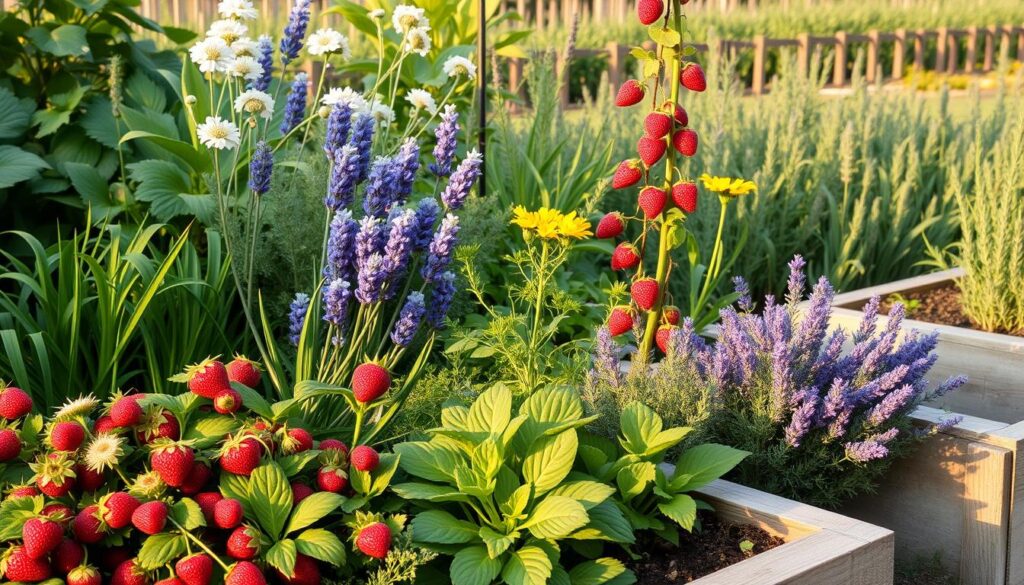
Legumes: Boosting Soil Nutrients
Incorporating legumes into your garden setup is a fantastic way to enhance the vitality of your raspberry plants. These legumes act as powerful raspberry garden buddies, enriching the soil and improving overall plant health. With their remarkable ability to fix nitrogen, peas and beans serve as indispensable allies in the realm of companion planting for raspberries.
Peas: Nitrogen Fixation
Peas are exceptional plants that benefit raspberries by fixing nitrogen in the soil. This process creates a nutrient-rich environment that fosters the growth of raspberry bushes. As a result, you can expect your berries to thrive and produce abundantly. In addition, these legumes have a relatively short growing season, allowing you to maximize your garden space effectively.
Beans: Improving Soil Health
Beans contribute significantly to the overall health of your garden soil. By preventing nutrient depletion, they create a sustainable ecosystem for your raspberries. This dynamic duo not only supports your fruits but also enhances soil structure, promoting better drainage and aeration. Embracing legumes in your planting strategy is a smart move for any gardener looking to cultivate a lush raspberry patch.

Herbs That Love Raspberries
Incorporating herbs into your raspberry garden can significantly enhance the garden’s productivity and health. These raspberry friendly plants serve as essential companions, providing unique benefits. Basil, mint, and thyme stand out as remarkable raspberry allies in the garden, each contributing to a thriving ecosystem.
Basil: Flavor Enhancement
Basil plays a pivotal role in enriching the flavor profile of nearby raspberries. Its aromatic leaves release oils that can improve the taste of fruits, giving your raspberries a delightful culinary edge. This herb thrives in warm weather, creating a harmonious connection with your raspberries during the growing season.
Mint: Attracting Pollinators
Mint is a favorite among gardeners for its ability to attract beneficial pollinators. The strong scent of mint draws in bees, butterflies, and other vital pollinators, essential for boosting raspberry yields. By planting mint near your raspberry plants, you can ensure a more productive garden while enjoying the refreshing aroma it brings.
Thyme: Benefiting Soil Microorganisms
Thyme contributes positively to the health of your raspberry plants by fostering a robust underground ecosystem. Its growth supports beneficial soil microorganisms, which help improve soil quality. A rich soil environment leads to healthier raspberries, making thyme a valuable addition to your gardening plan.
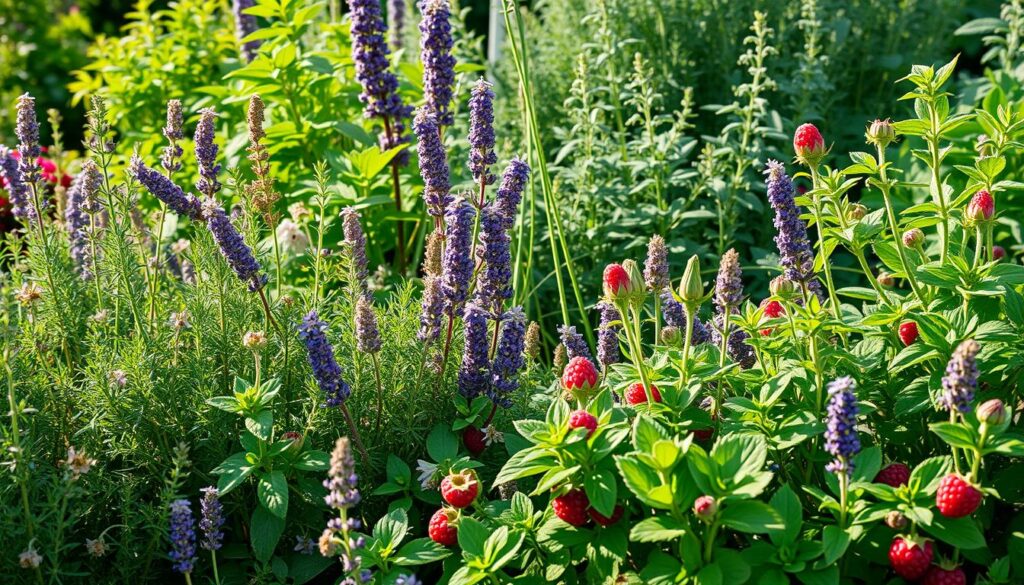
| Herb | Benefits | Suitable Conditions |
|---|---|---|
| Basil | Enhances raspberry flavor | Warm, sunny areas |
| Mint | Attracts pollinators | Moist, well-drained soil |
| Thyme | Improves soil microorganisms | Well-drained, sunny spots |
Vegetables to Pair with Raspberries
When planning your garden, considering the best plants to grow with raspberries can greatly enhance your yield and overall garden health. Among the top choices are lettuce and spinach, both of which thrive alongside raspberries. These leafy greens take advantage of the available space and resources, allowing for a productive garden layout.
Lettuce: Maximizing Space
Lettuce is a fast-growing vegetable that can be harvested before the raspberry plants reach their full height. This makes lettuce an excellent option to utilize scarce garden space efficiently. With various types of lettuce available, you can enjoy a diverse range of flavors and textures while benefiting from the shade the raspberry plants provide as they grow.
Spinach: Quick-Growing Benefits
Spinach not only complements raspberries in terms of space but also offers nutrients to the soil as it grows. This leafy green has a quick turnaround time from planting to harvest, allowing you to reap its health benefits early in the growing season. Planting spinach alongside raspberries supports a diverse ecosystem while maximizing the benefits of your garden.
| Vegetable | Growth Rate | Benefits When Paired with Raspberries |
|---|---|---|
| Lettuce | Fast-growing | Harvest before raspberries mature, utilizes space efficiently |
| Spinach | Quick-growing | Provides nutrients to soil, quick turnaround for early harvest |

Flowers That Complement Raspberries
Incorporating flowers into your raspberry garden can create a vibrant and functional environment. Certain flowers serve as excellent raspberry garden companions, offering both aesthetic appeal and significant benefits. Their presence can enhance pollination, provide shelter, and improve overall plant health. Here are a couple of flowers that can successfully benefit your raspberries:
Nasturtiums: Attracting Beneficial Insects
Nasturtiums are a fantastic addition to any raspberry garden. These colorful blooms serve to attract beneficial insects, including pollinators like bees, which are essential for raspberry flower fertilization. Additionally, nasturtiums can help deter pests such as aphids and whiteflies, ensuring a healthier environment for your raspberry plants. Their vibrant flowers can brighten up your garden while contributing positively to the ecosystem.
Sunflowers: Providing Shelter
Sunflowers not only add a striking height to your garden but also serve practical purposes. As sturdy plants, they act as natural windbreaks, aiding in protecting your raspberry bushes from harsh weather. Sunflowers also attract various pollinators and beneficial insects, increasing the flower activity around your raspberry plants. The combination of beauty and functional support makes sunflowers perfect raspberry garden companions.
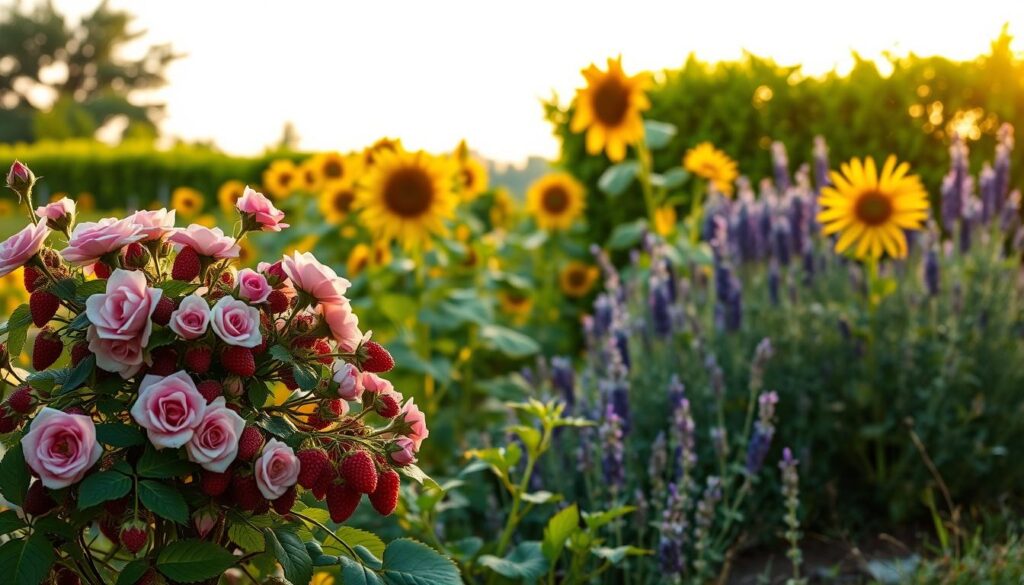
Avoiding Foe Plants for Raspberries
When cultivating raspberries, it’s crucial to consider the plants that may hinder their growth and health. Certain species can cause significant problems that affect your raspberry crop. Recognizing the raspberry companions to avoid can lead you to a more productive garden by steering clear of harmful neighbors.
Nightshade Family: A Risky Choice
Members of the nightshade family, including tomatoes, potatoes, and eggplants, present particular challenges. These plants can carry diseases like verticillium wilt, which can devastate raspberry plants. Their close proximity may increase the risk of disease transmission, making them plants that harm raspberries.
Other Companions to Avoid
In addition to nightshades, there are several other plants that can negatively impact your raspberries. For example:
- Broccoli: Competes for nutrients and light.
- Cabbage: Can attract similar pests.
- Strawberries: Sharing the same space may increase disease risk.
By being selective about your planting choices, you can help ensure a healthy and thriving raspberry harvest.
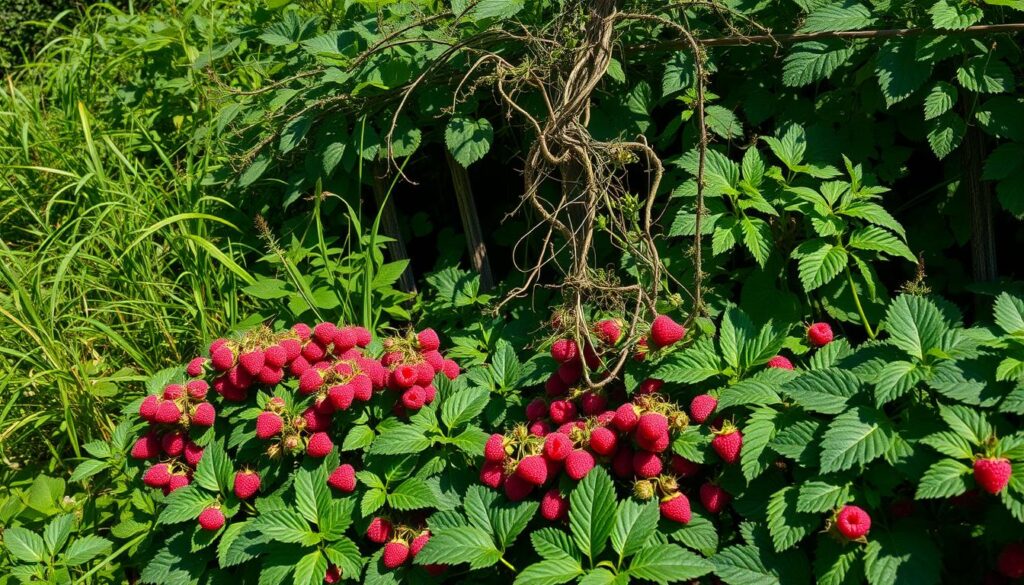
Care Tips for Companion Planting
When engaging in companion planting for raspberries, proper care begins with essential practices in soil preparation and watering. These foundational steps help ensure that your raspberry garden buddies thrive together, leading to a fruitful harvest.
Soil Preparation: Getting Ready
Start with soil that boasts a rich organic matter content and excellent drainage. This will cater to the specific requirements of raspberries and their companions. Adding compost or well-rotted manure to your soil creates a nutrient-dense environment, encouraging healthy growth for all plants involved. Testing your soil’s pH and amending it as needed can further enhance the conditions, ensuring a successful companion planting venture.
Watering: Balancing Needs
Watering strategies play a crucial role in maintaining the health of your raspberry garden buddies. Understand the different moisture requirements of each companion plant to avoid over-saturation. Light, consistent watering ensures that both raspberries and their companions receive adequate hydration. Implementing drip irrigation or soaker hoses can help achieve an even distribution of water, reducing the risk of root rot and other moisture-related issues.

Seasonal Planting with Raspberries
Understanding the seasonal changes in your gardening routine can greatly enhance the growth of your raspberry plants. Many gardeners consider spring the ideal time for planting raspberries alongside various companion plants. These initial days of growth set the stage for successful outcomes throughout the growing season. Implementing smart seasonal companion planting strategies leads to a thriving garden.
Spring Planting: The Best Time
During spring, the soil warms up, providing the perfect environment for planting raspberries. It is crucial to select healthy transplants and consider laying down mulch to maintain moisture. Emphasizing companion plants that thrive during this season, such as marigolds and legumes, adds not only aesthetic value but also fosters a healthy ecosystem for your raspberries. Following these raspberry garden tips will help your plants establish quickly and robustly.
Summer Care: Keeping Plants Healthy
As summer arrives, ongoing care becomes essential for the health and productivity of your raspberry plants. Regularly check for pests and signs of disease while ensuring the soil remains well-aerated and nutrient-rich. Fertilize as needed and provide adequate water, especially during dry spells. Observing these raspberry garden tips during the heat of summer helps ensure your companion planting flourishes alongside your raspberries, creating a resilient and productive garden.

Pest Control Strategies for Raspberries
Managing pests in your raspberry garden involves employing strategies that promote healthy plants while minimizing chemical use. Utilizing companion plants serves as an effective form of natural pest control. Selecting the right companions can deter harmful insects, allowing your raspberries to thrive without chemical interventions.
Natural Remedies Using Companion Plants
Specific companion plants are known to repel pests that commonly afflict raspberries. Marigolds, for instance, emit a scent that many insects find unappealing, making them a great addition to your raspberry patch. Garlic has antibacterial properties and can ward off various pests. Additionally, planting herbs such as basil and mint can attract beneficial insects that prey on harmful pests. These natural remedies contribute significantly to effective raspberry pest management.
Regular Monitoring: Staying Ahead of Issues
Keeping a close eye on your raspberry plants is key to maintaining a healthy garden. Regular monitoring allows you to catch early signs of infestation, whether through visual inspection or monitoring plant health. Look for unusual spots on leaves or signs of pest activity. Being proactive enables you to implement natural pest control measures before problems escalate, ensuring your raspberries remain productive and healthy.

| Companion Plant | Pest Repelled | Additional Benefits |
|---|---|---|
| Marigolds | Aphids, Whiteflies | Attracts pollinators |
| Garlic | Spider Mites, Aphids | Antibacterial properties |
| Basil | Thrips, Fruit Flies | Enhances flavor of raspberries |
| Mint | Ants, Flea Beetles | Attracts beneficial insects |
Enhancing Pollination with Companion Plants
Raspberry pollination strategies can greatly benefit from the inclusion of flowering companion plants in your garden. These plants play a crucial role in attracting pollinators such as bees, butterflies, and other beneficial insects. By creating an inviting environment for these creatures, you set the stage for increased fruit yields and overall garden health.
Flowering Plants: Attracting Bees
Many flowering plants thrive alongside raspberries, providing the nectar and pollen necessary for pollinators. Planting varieties like coneflowers, borage, and lavender helps to draw bees to your garden. The presence of these plants not only beautifies your space but significantly enhances your raspberry pollination strategies.
Creating a Pollinator-Friendly Garden
To successfully attract pollinators, consider the following tips:
- Choose a variety of flowering plants with overlapping bloom times.
- Avoid using chemical pesticides, which can harm beneficial insects.
- Incorporate native plants, as they are better suited to local pollinators.
- Provide shelter, such as brush piles or small wooden structures, for pollinators to reside.
By implementing these practices, you will attract pollinators effectively, resulting in healthy raspberries and a vibrant garden ecosystem.

Harvesting Tips for Raspberries and Companions
Successfully enjoying your raspberry bounty requires careful attention to timing and preservation techniques. Raspberry harvesting should occur when the fruits are fully ripe, ensuring maximum sweetness and flavor. Knowing the optimal time for harvesting leads to a more satisfying experience, both in taste and quality. Equally important is the way you handle those freshly picked raspberries as you prepare for preserving raspberries, so they can be savored long after the growing season ends.
Timing Your Harvests
Once you observe that your raspberries have turned a deep red color, it’s time to consider picking. The best approach includes checking for a firm but slightly soft feel, signaling ideal ripeness. During the harvest season, berries typically ripen in stages. Regular checks on your plants can help you identify the perfect moment for raspberry harvesting.
- Morning hours provide optimal conditions for harvesting, ensuring berries are cool and firm.
- Pick only the berries that easily detach from the stem without applying excessive force.
- Handle the fruits gently to prevent bruising and preserve freshness until you reach home.
Preserving Your Bounty
After your successful raspberry harvesting, preserving raspberries becomes essential to maintain their quality. There are various methods to preserve your fruits, including freezing, canning, or transforming them into delicious jams and jellies. Each method offers unique benefits and enhances your enjoyment of this luscious fruit throughout the year.
| Preservation Method | Description | Best For |
|---|---|---|
| Freezing | Quick freezing keeps berries fresh in a deep freeze. | Long-term storage while maintaining flavor. |
| Canning | Sealing raspberries in jars with sugar and water. | Creating shelf-stable options for recipes. |
| Jams and Jellies | Cooking raspberries with sugar and pectin for thickening. | Enhancing flavor palettes in various dishes. |
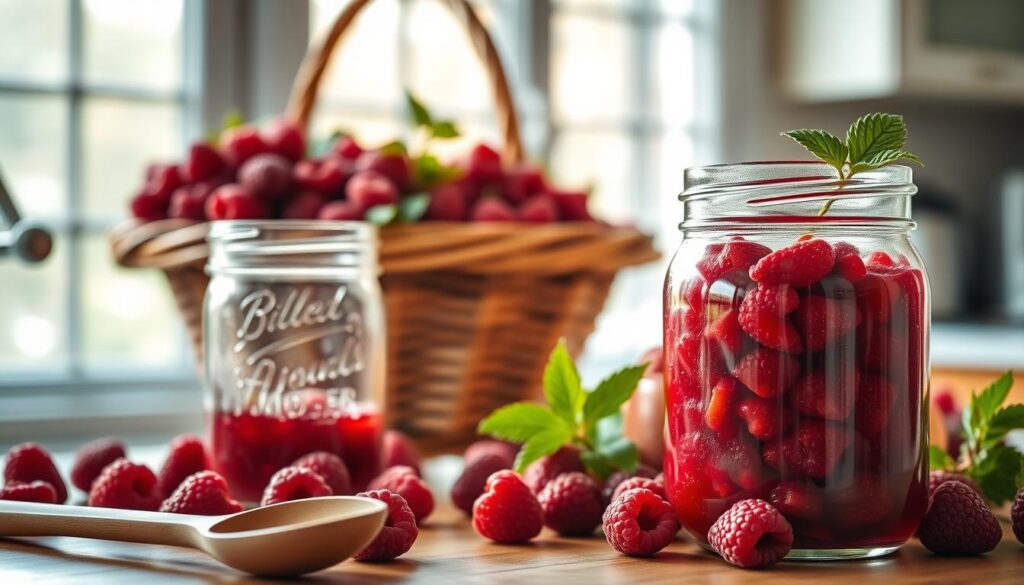
Organic Practices for Raspberry Companion Gardening
Embracing organic gardening practices can transform your garden into a thriving haven for both raspberries and their companion plants. By choosing organic seeds and utilizing natural pest prevention techniques, you not only enhance the health of your plants but also contribute positively to the environment. Here’s a closer look at these essential practices.
Choosing Organic Seeds
When starting your garden, selecting organic seeds is a fundamental step. These seeds are cultivated without synthetic pesticides or fertilizers, promoting healthier growth. Organic seeds can lead to more vigorous raspberry plants and healthier companion flora. Additionally, supporting organic seed producers fosters sustainable agriculture and biodiversity.
Natural Pest Prevention Techniques
Implementing natural pest prevention techniques is crucial in organic gardening. You can use various methods, such as:
- Beneficial insects like ladybugs and lacewings that naturally control pests.
- Homemade insecticidal soap or neem oil to deter harmful insects without harmful chemicals.
- Companion planting strategies using aromatic plants that repel pests alongside your raspberries.
These organic gardening practices create a harmonious ecosystem that encourages biodiversity, allowing your raspberry companion plants to flourish alongside your berry bushes.

Planning Your Raspberry Garden Layout
Creating an effective raspberry garden layout involves thoughtful planning to promote healthy growth and maximize yields. By considering the placement of companion plants, you can enhance your raspberry plants while optimizing sunlight exposure and airflow. Implementing a well-designed companion planting design will support the growth of your raspberries and contribute to a thriving garden ecosystem.
Companion Plant Arrangement Ideas
Selecting the right companion plants for your raspberry garden layout contributes significantly to both soil health and pest control. Arrange companion plants around your raspberries to promote interaction and benefits. Consider grouping flowers like marigolds nearby, as they attract pollinators and deter pests. You may place herbs like basil and thyme next to raspberries to enhance flavor and improve soil quality.
- Position taller plants, such as sunflowers, on the northern edge to prevent shading your raspberries.
- Incorporate legumes to fix nitrogen in the soil, planting them along the borders.
- Opt for spacing between rows to ensure ample airflow and light reaches all plants.
Maximizing Sunlight Exposure
Sunlight plays a crucial role in the health of your raspberry plants. Placing your raspberry plants in a layout that maximizes sunlight exposure will bolster their growth. Ensure that all plants in your companion planting design have access to sunlight throughout the day.
- Position shorter companion plants, like spinach or lettuce, in front of your raspberry rows to avoid blockage.
- Plant your raspberries in a south-facing garden area for maximum light exposure.
- Keep any shading plants at a distance to prevent competition for light and nutrients.
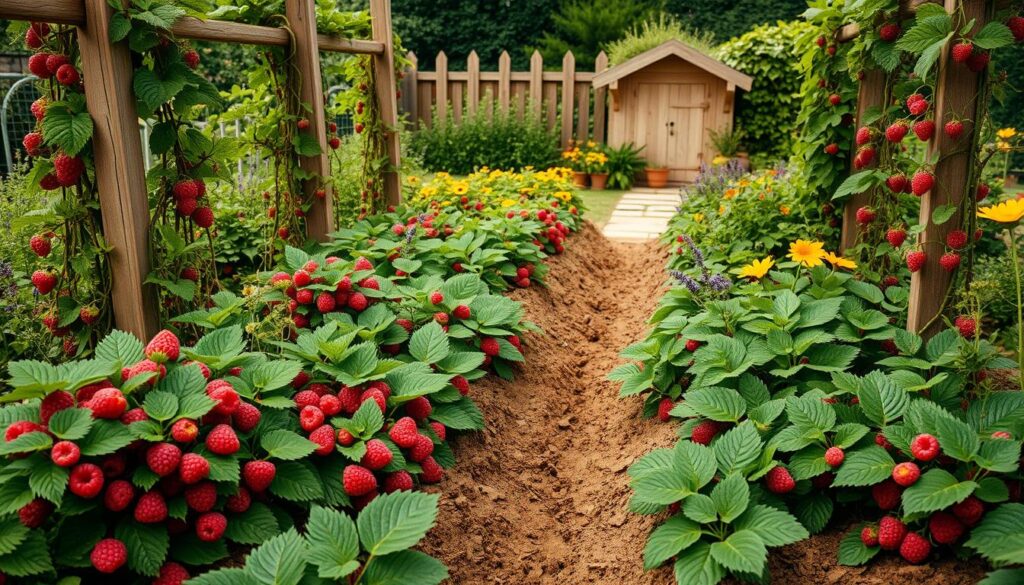
Common Mistakes to Avoid
Effective raspberry gardening relies on avoiding common mistakes in companion planting. One significant issue gardeners encounter is overcrowding their raspberry plants. When plants compete for limited resources, growth and yield can suffer. Proper spacing between plants allows for sufficient airflow and sunlight, promoting healthier development.
Overcrowding Your Raspberry Plants
Raspberry plants need space to flourish. When planted too closely together, they can hinder each other’s growth. Overcrowding leads to increased competition for nutrients and water. As a result, your yield may decrease, and plants become more susceptible to diseases. Following raspberry gardening tips, consider the ideal spacing for each plant. Generally, maintaining at least 24 to 36 inches between raspberry plants allows them to thrive properly.
Ignoring Maintenance Needs
Another crucial aspect of successful raspberry gardening involves regular maintenance. Neglecting these needs can result in poor plant health and reduced productivity. Tasks like pruning, watering, and fertilizing are essential. Lack of attention can lead to pest infestations and fungal diseases, complicating your gardening efforts. Embrace proactive maintenance routines guided by expert raspberry gardening tips to keep your garden flourishing.

Conclusion: A Flourishing Raspberry Garden
As you embark on your journey toward raspberry gardening success, the importance of companion plants cannot be overstated. By incorporating plants like marigolds, garlic, and legumes, you not only enhance the health of your raspberry bushes but also improve their yield. Each of these raspberry companion plants contributes uniquely to the ecosystem of your garden, creating a space that thrives on collaboration.
Recap of Key Companion Plants
Throughout this article, we’ve explored a variety of companion plants that foster healthy growth. Marigolds stand guard against pests, garlic acts as a natural deterrent, and legumes enrich the soil with nitrogen. Don’t forget the herbs and flowers that attract beneficial insects, making your garden a haven for pollinators. These combinations can truly lead to a flourishing raspberry garden.
Encouragement to Experiment and Learn
As you cultivate your raspberry patch, remember that gardening is a continuous learning experience. Feel free to experiment with different companion plants based on your garden’s conditions. Observe what works best in your unique environment; each season brings an opportunity to refine your strategies for raspberry gardening success. Embrace the process, and let your passion for growing raspberries guide you toward new discoveries.
